
|
Interstellar Medium:
| Readings: Schneider & Arny: Unit 72 |
| (Audio Lecture) |
When one looks up into the night sky we only see stars and the occasional planet. Most of outer space is empty, meaning that the density of atoms is much lower than even the best vacuums in our labs. Deep imaging of the skies showed that there are numerous regions where interstellar matter, in the form of gas and dust, collects to form clouds and nebula. Since these clouds are diffuse, they are difficult to see with the naked eye.

The first indication that there was interstellar gas and dust was dark lanes in the Milky Way. Since we live in a disk galaxy, then looking outward we see a band of light in the sky which, if magnified, breaks down into the many stars in our Galaxy. A deep photo of the Milky Way shows that there are dark regions or lanes.
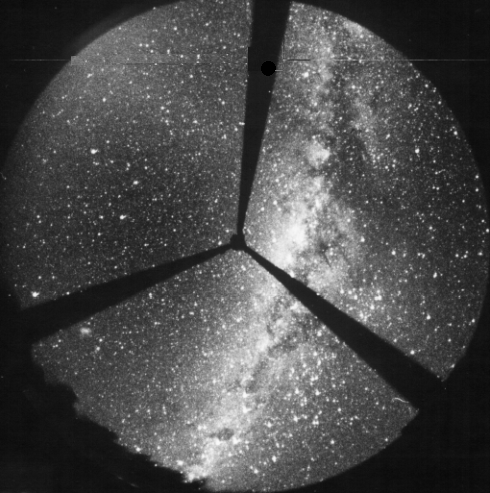
We understand now that there is gas and dust blocking the starlight which produces these dark lanes, such as the CoalSack Nebula. In fact, most of our Galaxy is blocked from our view by patches of gas and dust.
Interstellar Extinction:
Astrophotograph in the 19th century showed that the dark lanes or holes in the Milky Way did not have sharp edges. That, in fact, detail studies of star clusters at various distances from us showed that the intensity of light from remote stars is reduced as it passes through the sparse material of the interstellar medium. Herschel tried to use star counts to measure the size of the Galaxy and where our position is within it. His result was the diagram below, but what he really discovered was that interstellar extinction limits our line of sight.
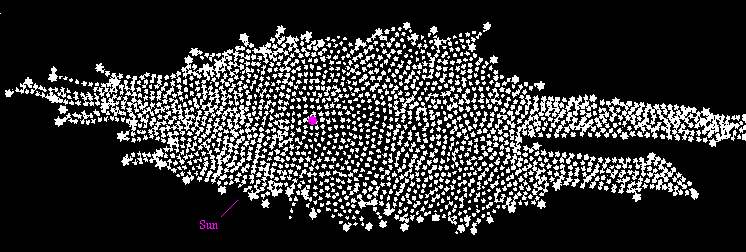
Not only is the intensity of the light decreased, called interstellar extinction, it is also reddened, called interstellar reddening. The blue component of light is more easily scattered than the red component (which is why the sky is blue during the day, scattered sunlight). Thus, light from remote stars has part of its blue component scattered before it reaches the Earth.
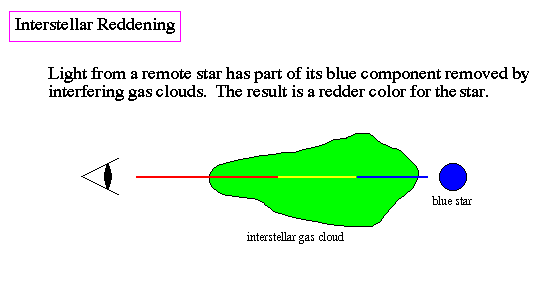
Maps of interstellar reddening demonstrated that the interstellar medium is composed mostly of hydrogen and helium gas (99%) and traces of dust. Dust, in an interstellar sense, is very small (few microns in size) particles of carbon and silicon. Dust is fragile because it can be broken down by UV photons, but is very important in dark nebula as sites for the formation of molecules.
Neutral Hydrogen:
Most of the interstellar medium is in the form of neutral hydrogen gas (HI). The typical densities of neutral hydrogen in the Galaxy is one atom per cubic centimeter. This gas is cold and the electron is usually in its ground state. However, protons and electrons can have spin. This spin produces a magnetic field such that when the spins are aligned the ground state has a slightly higher energy then when the spins are opposed. This is called hyperfine splitting of the ground state for hydrogen and results in the emission of 21 cm radio waves from HI clouds.
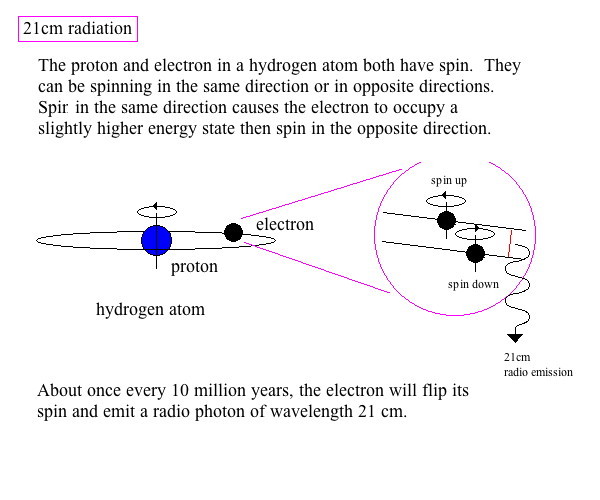
The spins of the electron can be changed by collisions with other hydrogen atoms, although this is very rare because the densities are so low, or the transition can happen naturally after a few million years. On the other hand, there are billions and billions of hydrogen atoms in the typical cloud of gas. So the result is that 21 cm is a strong measure of the amount of HI gas in the Galaxy.
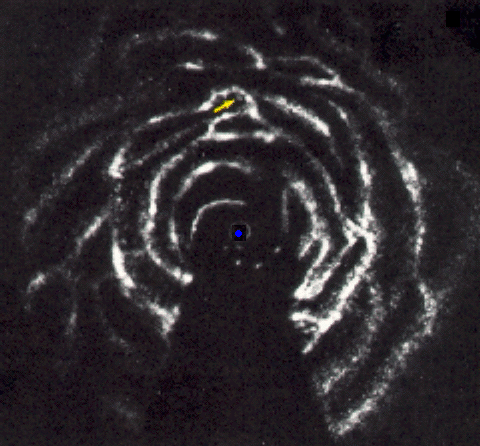
A scan of our Milky Way galaxy at 21 cm shows that the distribution of neutral hydrogen is concentrated in the spiral arms. The Sun is marked as the yellow arrow, Galactic center is a blue dot. Notice how there is a cone of avoidance behind the Galactic center due to confusion in the HI signal.
Interstellar Molecules:
Atoms can bond together to form molecules. The most common atoms in the Universe are H, He, C, N, O, thus we have the expectation that the most common molecules are made from these atoms. However, the bonds between molecules is very weak (look how easy it is to breakdown water) and interstellar space is full of UV and x-ray photons which can break these bonds. So interstellar molecules are only found in the dark centers of dense nebula of gas and dust.
Just as electrons orbit around the nucleus in quantized energy states, atoms can rotate around each other, also in quantized speeds. Changes in the rotation, by collisions or interactions, will emit photons.
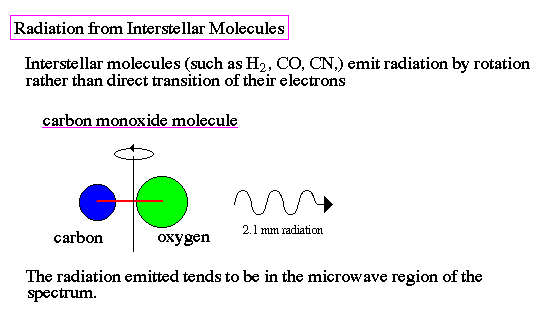
Radiation from interstellar molecules is a good tracer of the dense, thick regions of the interstellar medium. These dense regions are usually the sites of protostar formation and collapse of large clouds of gas to form into star clusters.
Interstellar Dust:
Interstellar dust is produced in the envelopes around red supergiant stars. Stellar winds and the planetary nebula phase eject this dust into the interstellar medium. Dust particles are mostly carbon and silicate grains that are a few microns in size. Although small, they completely absorb any light that strikes them and are heated by collisions with gas molecules. They will be warmed to the ambient temperature of the surrounding region and re-radiate that energy in the far infrared.
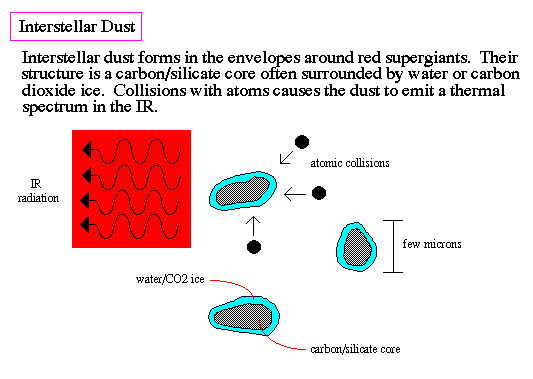
Although solid objects, dust grains are not immune to destruction. Collisions with high speed gas particles, UV photons and other grains will breakdown dust grains. For this reason, dust is only found in the cores of dark nebula where they are shielded from destructive effects.
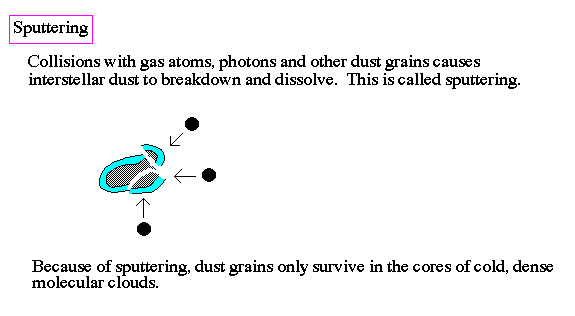
Dust grains serve as sites for the formation of molecules and organic compounds. Their cold surfaces act as catalysts by allowing atoms to stick to them so there there is time for a second atom to land, interact, and form a molecule. Collections of dust and molecular gases are called molecular clouds.
Dark Nebula:
We divide the interstellar medium into three types dependent on their temperature (called the phase of the interstellar medium): cold (10's K), warm (100 to 1000's K), hot (millions K). The colder a cloud of gas, the more of its output emission is in the long wavelengths; radio and microwave. Hot regions of interstellar gas are bright in their own optical emission.
Note also that the various temperatures determine the type of matter that will exist. Cold temperatures are suitable to the formation of molecules. Warmer temperatures will find only atoms, such as neutral hydrogen. Under higher temperatures, atoms become ionized (HII regions). The coldest regions of space are the dark nebula.
Some dark nebula are found through star counts, such as the Coalsack. Others are visible because an emission nebula is behind them, so they are illuminated from behind, such as the Horse Head Nebula shown below. This happens often because the same gas that is associated with the dark nebula can also be heated by nearby stars to glow as an emission nebula.
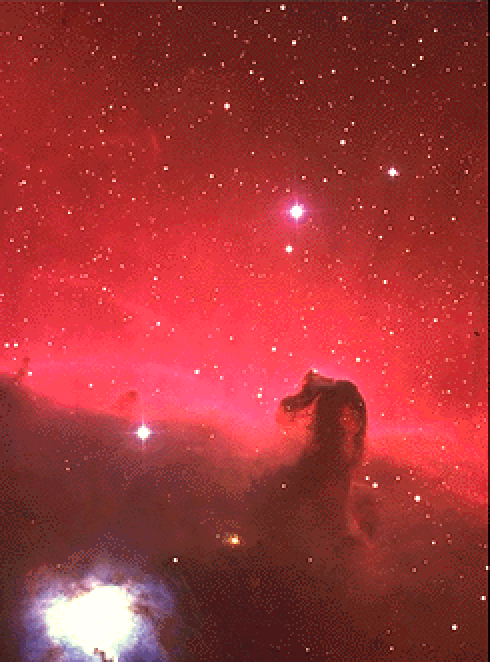
The Horse Head Nebula is several tens of parsecs across and would envelop the local neighborhood of stars around our solar system. Stars seen in the image are foreground stars since the nebula is opaque.
Some dark nebula are surrounded by emission regions, giving the impression that the dark cores are being dissolved by the hotter gas as in the Eagle Nebula shown below.
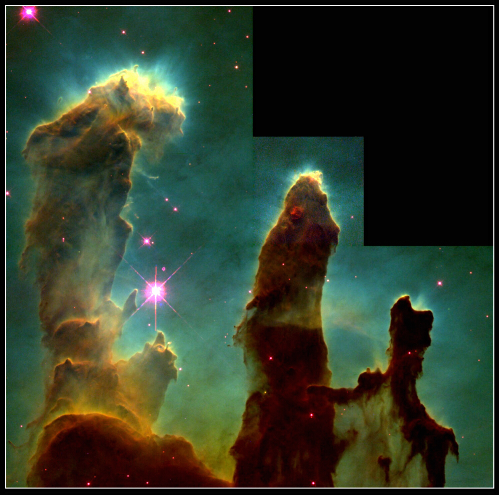
A great deal of information is contained in the above image, the irregular shape of the dark regions, the hot vapor off the edges heated by nearby stars, the straight rays of dissolved gas. This nebula indicates that the interaction between dark nebula and bright, hot gas is dynamic and ongoing.
Molecular Clouds:
Often in the centers of dark nebula are dense concentrations of gas and dust called molecular clouds. They are called molecular because the temperatures are so low (only a few 10's K) that H2 and CO can form on the surface of dust grains. Dense gas makes for instability to gravity, and large pieces of the cloud can collapse to form protostars. Thus, molecular clouds are important as `nurseries' for young star clusters.
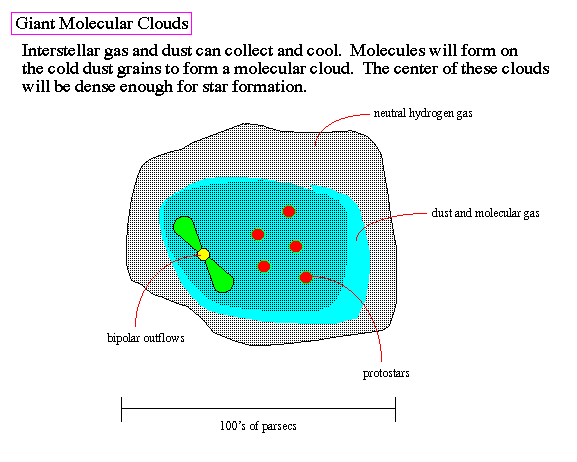
Molecular clouds are probed with far infrared and sub-millimeter telescopes to study the conditions that lead to star formation and the details of protostar evolution. As the young stars evolve and heat the leftover gas, the molecular cloud will be destroyed and turned into a HII region such as the Orion Nebula.
A perspective plot of the location of molecular clouds towards the center of the Galaxy is shown below. The location of the Sagittarius and Scutum spiral arms are clearly outlined.
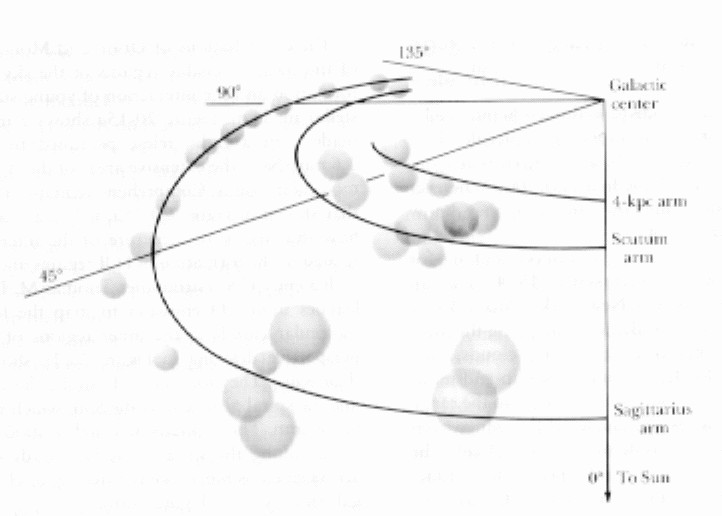
There are many processes that go on inside a molecular cloud that can enhance or inhibit the formation of stars. For example, turbulence in the core of a cloud would compress some regions and enhance star formation. Magnetic fields would retard the collapse of a cloud and slow down the production of new stars.

|
|

|